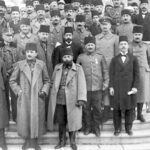In the last period of the Ottoman Empire, different currents of thought emerged in order to prevent the disintegration and collapse of the state. Ottoman intellectual currents came to the fore with their efforts to preserve or transform the social, cultural and political structure of Ottoman society.
The three main currents that came to the fore in this period were Ottomanism, Islamism and Turkism. Ottomanism aimed to unite all nations under the Ottoman identity while preserving the multinational structure of the empire.
This movement, supported by groups such as the Young Turks and the Young Ottomans in the late 19th century, aimed to establish a constitutional monarchy and bring peoples together by developing the concept of Ottoman citizenship. However, the Balkan Wars and the territorial losses of the empire reduced the effectiveness of this movement, and the unifying effect of Ottomanism weakened over time.
The Islamist movement, on the other hand, is based on the idea of gathering Muslims under a religious unity in the Ottoman Empire. II. This movement, which gained strength during the reign of Abdulhamid, aimed to make the Ottoman Empire the leader of the Islamic world as the center of the caliphate.
Islamism, which is an effort to increase unity and solidarity especially among Muslim peoples, aimed to achieve unity among the Muslim subjects of the Ottoman Empire. However, the independence movements that emerged in the Arab world and the contradictions in the Ottoman relations with the West caused this trend to weaken. After this event, the currents of thought in the Ottoman Empire were replaced by Turkism.
Ottoman Intellectual Movements and Representatives

In the long and turbulent history of the Ottoman Empire, many currents of thought have emerged, shaped by internal and external factors. Ottoman intellectual currents deeply affected the state’s understanding of administration, social structure and vision for the future.
- Ottomanism
- Islamism
- Turkism
- Westernism
Among the Ottoman currents of thought, Ottomanism was first adopted as a state policy. Ottomanism is based on the idea that all Ottoman citizens should come together and form a common identity, regardless of religion, language and race.
The main purpose of this movement is to ensure the integrity of the empire and strengthen the unity between different ethnic groups. Among its representatives are Namık Kemal, Mithat Pasha and Şinasi.
Westernism is a movement that argues that the Ottoman Empire should modernize and modernize by taking Western civilization as an example. The Westernism movement aims for the state to make radical reforms in the political, economic and social fields. The reform movements that started with the Tanzimat Edict are one of the most important practices of the Westernism movement. Tevfik Fikret is an important representative.
Ottoman Intellectual Movements Chronological Order
In the long and turbulent history of the Ottoman Empire, many currents of thought have emerged, shaped by internal and external factors. The intellectual currents of the Ottoman Empire deeply affected the political, social and cultural structure of the state and offered different visions about the future of the empire.
- Ottomanism
- Islamism
- Turkism
- Westernism
It is known as the chronological order of Ottoman intellectual movements .
These currents of thought that emerged in the Ottoman Empire offered different solutions to the internal and external problems of the state. While Ottomanism aimed to preserve the integrity of the empire, Islamism wanted to re-establish leadership in the Islamic world.
Turkism, on the other hand, defended the national unity and independence of the Turkish nation, while Westernism tried to imitate the modernization processes of the West. The interaction and contradictions of these movements shaped the political and social transformations in the last period of the Ottoman Empire.










